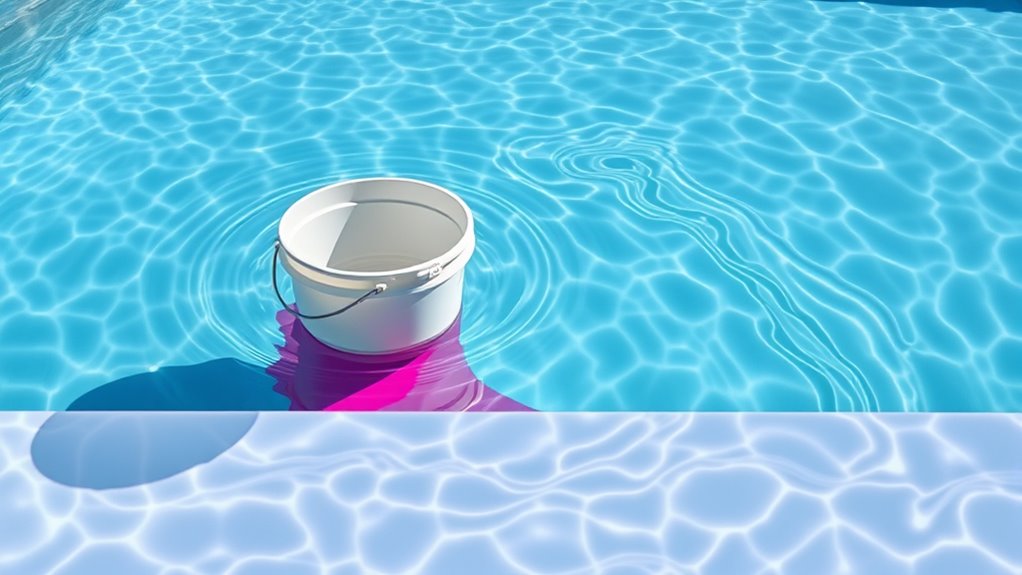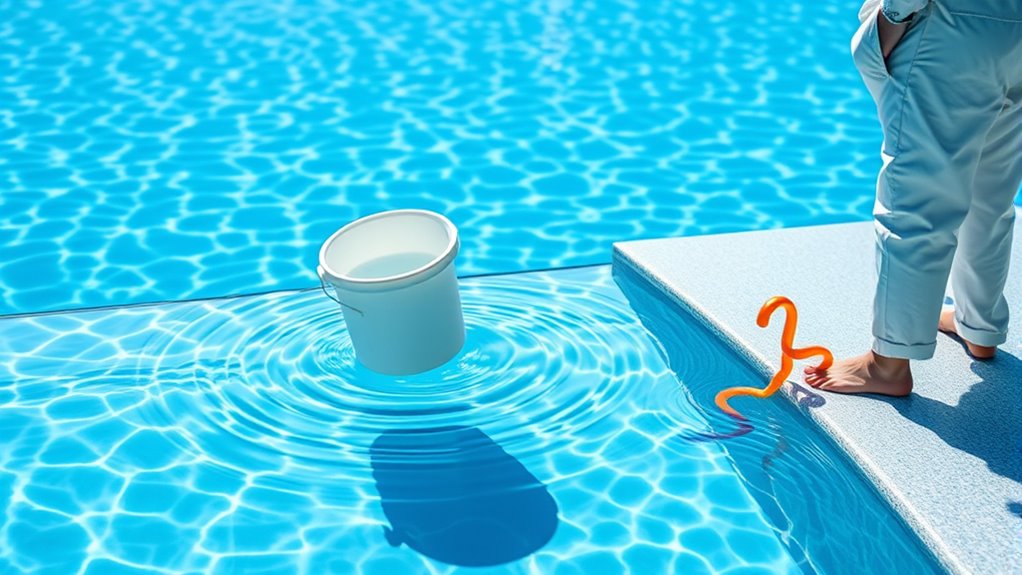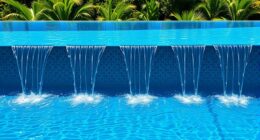When trying to find a leak in your vanishing-edge system, a bucket test offers a simple, cost-effective way to spot water loss by monitoring levels over time. If you need to pinpoint the leak more accurately, a dye test reveals exact leak points by observing dye movement. Each method has pros and cons, so choosing the right one depends on your system’s complexity and your budget. Keep going to uncover more tips.
Key Takeaways
- Bucket tests are simple and non-invasive but less precise for pinpointing leaks in vanishing-edge systems.
- Dye tests provide accurate leak location by visualizing dye movement, suitable for complex vanishing-edge setups.
- Environmental factors like evaporation can affect bucket test results, requiring careful timing and controls.
- Dye tests involve turning off pumps and accessing plumbing, which may be more invasive and costly.
- Choosing between methods depends on system complexity, leak size, and budget considerations for vanishing-edge pools.
Understanding the Principles Behind the Bucket Test and Dye Test

To understand how the bucket test and dye test work, it’s important to grasp their basic principles. The bucket test relies on observing water levels over time to detect leaks. You fill a bucket with water and mark the water line, then monitor if it drops without any use of the system. If the water level decreases, it indicates a leak somewhere in the system. The dye test, on the other hand, uses a colored dye added to the water. You introduce the dye into the system and watch for visible color escaping from potential leak points. Both methods are simple, yet effective, relying on visual cues to identify leaks. They serve as initial inspections to determine if further, more detailed testing is necessary. Additionally, understanding the effectiveness of filtration can help identify if the water is being contaminated or lost through leaks, emphasizing the importance of these simple testing methods.
Step-by-Step Process for Conducting the Bucket Test

Start by gathering the necessary materials: a large, clear bucket, a permanent marker, and a water source. Place the bucket on the pool deck directly beneath the vanishing-edge spillway. Fill the bucket with water, about halfway full. Use the permanent marker to draw a line across the bucket’s surface at the water level. Carefully observe the water level for a few minutes, ensuring no evaporation or splashing affects the reading. Keep the bucket steady and undisturbed. After five or ten minutes, check the water level again. If it’s lower than the marked line, you have a leak. If it stays consistent, your system is likely leak-free. This simple test helps identify leaks without complex equipment or invasive procedures, and understanding the contrast ratio of your system can further enhance your visual assessment.
How to Perform an Effective Dye Test for Leak Detection

Performing an effective dye test involves carefully introducing a dye into the pool’s plumbing system to pinpoint the leak’s location. First, turn off the pool pump to prevent circulation. Access the skimmer or pump area and add a concentrated dye—usually a non-toxic, visible color—directly into the skimmer, pump basket, or a designated plumbing line. Ensure the dye is placed where you suspect the leak or in a strategic location to trace the system. Turn the pump back on and watch closely for the dye’s movement. If the dye moves toward a specific spot or escapes from the plumbing, you’ve identified the leak’s general area. Record your findings for further inspection or repairs.
Advantages and Limitations of Each Method

Both the bucket test and dye test offer unique advantages for detecting leaks, but they also come with certain limitations. The bucket test is simple, inexpensive, and allows for quick assessment, but it may miss small or hidden leaks. It’s less precise and can be affected by evaporation or splashing. The dye test, on the other hand, provides more accurate identification of leak locations, especially in complex systems, but it requires additional materials and takes more time. It’s also more invasive, risking contamination if not managed carefully. Additionally, understanding the principles of ethical hacking can help in developing secure testing methods to prevent system vulnerabilities during leak detection processes.
- The bucket test is quick and cost-effective but less precise.
- The dye test offers pinpoint accuracy but takes longer and costs more.
- The bucket test can be affected by environmental factors.
- The dye test requires careful handling of dye and equipment.
Choosing the Right Technique for Your Vanishing-Edge System

Choosing the right leak detection technique for your vanishing-edge system depends on the system’s complexity, your budget, and the level of accuracy you need. If your system is straightforward with easily accessible components, a bucket test offers a quick, cost-effective solution. It’s ideal for identifying large leaks and confirming water loss rates. However, if you require pinpoint accuracy and can invest more time and resources, a dye test is more suitable. Dye tests help locate small or hidden leaks by tracing water movement precisely. Consider the system’s design and your expertise; for complex setups, professional inspection may be necessary. Additionally, understanding the reliability of testing methods can help you make an informed decision. Ultimately, balancing your budget with the desired accuracy will guide you to choose the most effective leak detection method for your vanishing-edge system.
Frequently Asked Questions
Can Environmental Factors Influence the Accuracy of Leak Detection Tests?
Yes, environmental factors can influence the accuracy of leak detection tests. For example, wind can cause dye or water to disperse unevenly, making leaks harder to identify. Temperature changes may affect dye visibility or water flow rates. Rain or heavy humidity can dilute dye or obscure signs of leaks. You should consider these factors to guarantee reliable results and, if possible, perform tests during stable weather conditions.
How Often Should Leak Tests Be Performed on Vanishing-Edge Systems?
You should perform leak tests on vanishing-edge systems at least once a year to guarantee they remain leak-free. Regular testing helps catch small issues before they become major problems, especially after heavy storms or system maintenance. If you notice any water loss or irregularities, conduct additional tests promptly. Consistent testing keeps your system functioning at its best and prevents costly repairs, maintaining the aesthetic and safety of your installation.
Are There Safety Concerns Associated With Dye Testing?
Yes, there are safety concerns with dye testing. You should handle the dye carefully, avoiding ingestion or skin contact, as some dyes can cause irritation or allergic reactions. Make sure to wear gloves and eye protection. Keep the dye away from children and pets, and follow manufacturer instructions for proper use. Proper disposal of the dye afterward is essential to prevent environmental contamination.
What Are the Costs Differences Between Bucket and Dye Tests?
You’ll find that bucket tests are generally cheaper since they only need a simple bucket and basic tools, costing just a few dollars. Dye tests, however, involve purchasing dye, which can range from $20 to $50 or more, plus potential professional fees if you hire someone to perform the test. Overall, bucket tests are more budget-friendly, but dye tests offer more precise leak detection.
Can These Tests Detect Micro-Leaks or Only Large Leaks?
Both tests primarily detect larger leaks, but dye tests can sometimes identify smaller, micro-leaks if you use highly sensitive dye. However, if the leak is very tiny, neither test guarantees detection. You might need more advanced methods, like pressure decay testing or electronic leak detectors, for pinpointing micro-leaks. It is crucial to combine these methods with careful inspection to guarantee you catch even the smallest issues.
Conclusion
Think of leak detection like steering a river’s flow—you need the right tool to spot where water escapes. The bucket test is your sturdy paddle, giving a quick overview, while the dye test is your fine-tipped compass, pinpointing tiny leaks. Choose wisely based on your journey’s needs. With both methods, you’re better equipped to keep your vanishing-edge system flowing smoothly—like a river running clear and true.









